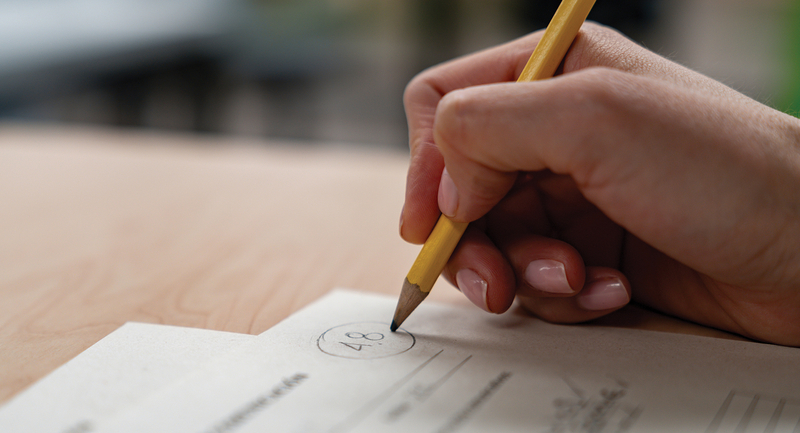Observations only scratch the surface. To evaluate teachers fairly and accurately, principals need to know what goes on behind the scenes.

Premium Resource
After 20 years as teacher educator, I was beginning to feel that my teaching had lost its edge. My life as a college professor was clearly out of touch with daily life in schools, and the changes in the past 20 years were making the teaching and administration that I had done before becoming a teacher educator seem quaint. So when I was offered the opportunity to serve as the principal of a small charter school in East Los Angeles, I knew it was something that I had to do.
I arranged for a leave from my university and assumed leadership of a 250-student, 16-teacher high school. I was full of hope and believed that I could provide the school with the kind of leadership it had been lacking for a number of years, especially in the area of instructional support.
In my initial classroom observations, I used an agreed-upon standards-based teacher evaluation instrument. When I arrived in the classrooms, teachers would give me clear lesson plans, either inside a thick notebook that contained plans for the full year or on a single sheet of paper. I found that many teachers posted standards and essential questions and moved effortlessly around the classroom checking for understanding. Most students were alert and engaged, and classrooms were bright and lively, albeit messy.
Yet, in post-observation conferences I found myself having to ask questions about certain essential practices. How did the teachers use formative assessments to drive instruction? What was their plan for differentiating instruction? Did they use strategies other than walking around the classroom to check for understanding? How was their lesson linked to the essential questions on display?
After these initial observations, I started making random, unannounced classroom visits, which gave me a fuller understanding of what was happening in classrooms. Still, when students saw me open the door, they sat up straighter, and teachers came out from behind their desks. I was beginning to feel that I was watching performance art pieces rather than authentic classroom moments. These classroom visits showed me only isolated segments of each teacher's work. There might be projects posted around rooms and student work in the hallways, but I didn't have easy access to the instructional documents that scaffolded this work. I didn't know how much support the students had in completing the work or what teacher directives had shaped that work.
It seemed to me that there must be a way to get a more robust view of teachers' practices. Although using student test scores in teacher evaluations is gaining acceptance, standardized tests cannot fully measure student learning, and they certainly are not designed to measure teacher performance (Darling-Hammond, 2010; Popham, 2001). Portfolio assessments, like those for initial teacher certification and the National Board certification, provide a different model for using student work and teaching documents to assess teacher performance. Might that approach be applicable to teacher evaluations?
Instructional supports like rubrics, project guidelines, discussion guides for films, and group-work guidelines are not typically part of performance assessments of teachers; however, without reviewing these documents, we cannot accurately assess teacher effectiveness and how it supports student learning. I began talking with teachers about these design documents and what such materials could tell us about their teaching and about student learning. (I like to call these items design documents because the term design encourages teachers to think about themselves as designers of learning opportunities.) The lesson plan typically tells us what teachers think they are going to do on that day; design documents, on the other hand, make clear where the teacher wants students to go with their work. If well done, they also provide guidance on how to get there.
What kinds of documents and data should be part of a more robust assessment of teacher effectiveness? The following are my candidates for inclusion.
A math teacher led our school's effort to develop a questionnaire for students about their classroom experiences. He worked with his calculus students, finding sample instruments online, which students reviewed and edited. The faculty spent much of the remainder of the year discussing the format of the questionnaires and debating how they would be used in formal teacher assessments. In the end, we agreed that teachers would administer the questionnaire at the end of the year. They would share the results with me only if they wished.
Five of the 15 teachers in the school chose to share the results, and we had rich and rewarding conversations about their teaching as seen through the eyes of their students. One math teacher found that her students felt she didn't get to them fast enough when they were working independently and had questions. In response, she decided to pay considerably more attention to students whose hands were up, asking for help. In addition, she always circled back to these students to see whether they had been successful in solving the problem. She also now follows up on her assistance by asking students their own question back to them to see if they can answer it before she moves on.
Another teacher was puzzled by a student response to the question, "Is there anything the teacher could have done better?" The student stated, "Be a Chargers fan." The teacher came to see that the student was asking him to become engaged in the student's world. This same teacher reflected that going through this process at the end of the year was more like an autopsy than a check-up, so next year he plans to administer the questionnaire three times during the school year.
I spent hours reviewing teachers' grades, getting a sense of their grading practices and trying to find out why the student grades were so low. The school had failed to meet its growth targets in math for two years running; as a result, there was tremendous pressure to improve student performance in math.
As I began to examine graded math tests, I found that teachers often returned math tests with missed problems marked and an overall score with a percentage at the top of the page. For reteaching, they merely reviewed tests the day they returned them. I pushed the teachers to find out why students made mistakes by carefully analyzing how the students worked out the problems. I wanted the teachers to know that behind each wrong answer lay a variety of misconceptions that they needed to uncover (Lochhead & Mestre, 1988).
Reviewing English teachers' graded papers with them told me more about their approach to teaching writing and their standards for student writing than I could get from watching them teach. Reviewing their rubrics provided an opportunity for me to engage them in a discussion about what to include in the assessment of student written work. The English department eventually decided to use the 6 + 1 Traits of Writing as a framework in all English classes for the next school year, and they began developing a common rubric that they hoped other departments would adopt.
My early discussions with teachers about grading expanded into an ongoing discussion about the larger question of grading, namely, what should be included in the calculation of semester grades. Teachers were used to including homework grades, attendance points, tardy points, citizenship points, and extra credit. Once we began to examine it, this "kitchen sink" approach raised all kinds of questions in teachers' minds. Teachers were concerned that this kind of grading masked students' true levels of achievement and led to the misplacement of students in classes. At faculty meetings, we reviewed the work of Ken O'Connor (2007) on grading and determined that in the coming year the school would move toward standards-based grading.
I became particularly fond of looking at one English teacher's discussion guides for the films she showed. Reviewing these helped me understand her lessons and the ways she linked her essential questions to films. When she taught the book The Absolutely True Diary of a Part-Time Indian by Sherman Alexie (Little, Brown, 2007), she also showed the film Smoke Signals, which Alexie wrote the screenplay for. She developed the film guide in conjunction with a history teacher, so the discussion questions supported essential questions about both American Indian history and identity development. Without the guide, the students would have been unable to make the connection between a history of oppression and an individual's identity development, nor would they have seen the literary techniques that the film employed.
Reviewing project guidelines with teachers helped me understand why some teachers had powerful results from project-based instruction and others had projects that appeared to belong more in middle school than in high school. In one world history project, students were given a detailed set of guidelines, which included dressing as the historic figures the students had researched. When students presented their projects, the school was filled with the likes of Che Guevara and Frida Kahlo. The clear pleasure the students exuded on that day revealed their engagement in the work.
Toward the end of the year, teachers began working with their departments to develop common rubrics, project guidelines, and grading standards. This provided teachers an opportunity to share the design documents that they used to scaffold student learning. In addition, because of this collaboration, students are spared the confusion of having different standards and guidelines in each of their classes.
Looking at these specimens of teacher work gives administrators a window into teaching practice that classroom visits alone cannot. It helps us paint a more complete picture of teachers' approach to their craft and can provide a focus for discussions. In addition, it expands our thinking about what effective teaching means. These documents help administrators and other teacher evaluators get a more robust sense of what teachers gave students to support their learning. Once we know this, we know much more about why student learning levels are what they are and how teachers might increase student achievement.
Sharing these documents opens teachers up to collaboration and support. In many ways, teachers are the best professional developers of their fellow teachers. Enabling teachers to learn from one another may be the most effective way to spread best practices throughout a school.
Yet this kind of granular analysis can be hard for both teachers and administrators. For administrators, it is time-consuming. The fast-paced life in schools works against reflective analysis, which requires uninterrupted time. For teachers used to working in the privacy of their classrooms, sharing can be intimidating. Plus, they need time to incorporate feedback into their own professional practice.
But without documentation of a teacher's work, we are only looking at teacher effectiveness through a narrow lens of classroom observation and, more recently, student standardized test scores. Looking at all the work teachers do, not just their time in front of a class, moves us to a more robust understanding of which teaching practices have a significant effect on student learning.
The initial plan for this project was that I would be at the high school for two years to ensure that the reforms could take root, but budget cuts at both the charter school and the university where I teach have forced me to return to university teaching. However, what we accomplished in one short year convinced me that the detail with which teacher educators evaluate student work in a teacher education program—by, for example, collecting design documents and other materials—could serve as a good model for evaluating the work of classroom teachers. Sadly, most administrators do not have the time needed for critical readings of teachers' design documents and their grading practices. But by giving careful attention to just one set of graded papers or tests or design documents, administrators can not only honor this part of teacher's work but also begin conversations that lead to significant changes in a school.
References
•
Darling-Hammond, L. (2010). Policy brief: Recognizing and developing effective teaching: What policy makers should know and do. Washington, D.C.: Partnership for Teacher Quality.
•
Lochhead, J., & Mestre, J. P. (1988). From words to algebra: Mending misconceptions. In A. F. Coxford & A. P. Shulte (Eds.), The ideas of algebra, K–12: The 1988 yearbook of the National Council of Teachers of Mathematics (pp. 127–135). Reston, VA: National Council of Teachers of Mathematics.
•
O'Connor, K. (2007). A repair kit for grading: 15 fixes for broken grades. Princeton, NJ: Educational Testing Service.
•
Popham, J. (2001). The truth about testing: An educator's call to action. Alexandria, VA: ASCD.








